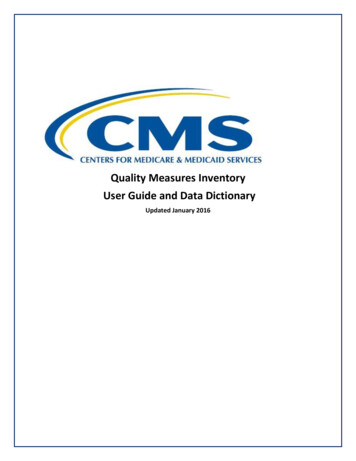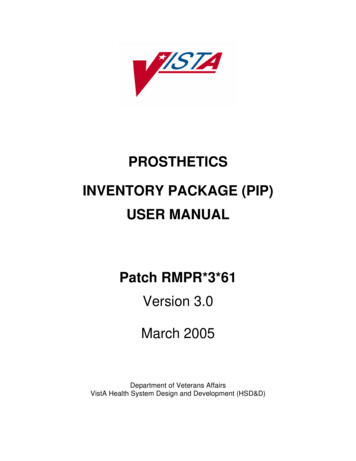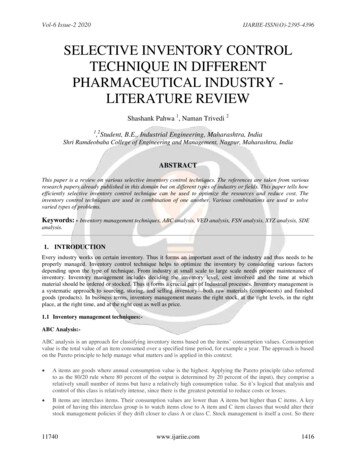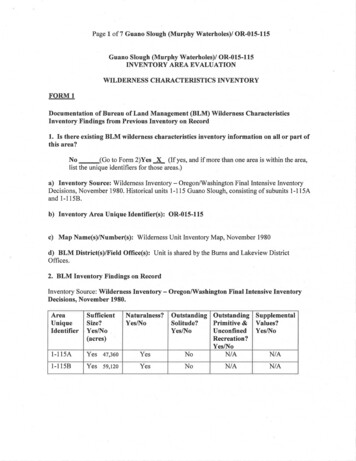
Transcription
Quality Measures InventoryUser Guide and Data DictionaryUpdated January 2016
Table of ContentsIntroduction . 3Purpose . 3How to Navigate the Document . 4Chapter 1: Programs . 51.1Represented Programs . 51.2Future Programs . 6Chapter 2: Data Dictionary. 62.1 Measure Specifications . 6Chapter 3: Navigating the Inventory . 103.1 Inventory Tabs . 103.2 Filtering by Program . 113.3 Filtering by Program and Status . 123.4 Clearing Filters . 13Chapter 4. Updates . 13Appendix A: Glossary . 141
ESRDESRD QIPHACRPHHQRPHIQRHOQRHQMFHQRPHRRPHVBPIPFQRIRF QRPLTCH QRPMAPMATMIFMIPSMSSPMUCNQFPCHQRPDFPPSSNF QRPSNF VBPDefinitionPatient Protection and Affordable Care Act of 2010Ambulatory Surgical Center Quality Reporting ProgramCritical Access HospitalsConsensus Development Process (NQF)Centers for Medicare and Medicaid ServicesDepartment of Health and Human ServicesElectronic Clinical Quality MeasureEligible HospitalElectronic Health RecordEnd-Stage Renal DiseaseEnd-Stage Renal Disease Quality Incentive ProgramHospital-Acquired Condition Reduction ProgramHome Health Quality Reporting ProgramHospital Inpatient Quality Reporting ProgramHospital Outpatient Quality Reporting ProgramHealth Quality Measures FormatHospice Quality Reporting ProgramHospital Readmissions Reduction ProgramHospital Value-Based Purchasing ProgramInpatient Psychiatric Facility Quality Reporting ProgramInpatient Rehabilitation Facility Quality Reporting ProgramLong-Term Care Hospital Quality Reporting ProgramMeasure Applications PartnershipMeasure Authoring ToolMeasure Information FormMerit-based Incentive Payment SystemMedicare Shared Savings ProgramMeasures under ConsiderationNational Quality ForumProspective Payment System (PPS)-Exempt Cancer Hospital Quality ReportingProgramPortable Document FormatProspective Payment SystemSkilled Nursing Facility Quality Reporting ProgramSkilled Nursing Facility Value-Based Purchasing Program2
INTRODUCTIONThe Centers for Medicare and Medicaid Services (CMS) publishes the CMS Quality MeasuresInventory to comply with Section 3014 of the Patient Protection and Affordable Care Act of2010 (ACA), which created sections 1890A of the Social Security Act and requires theDepartment of Health and Human Services (DHHS) to develop a process for dissemination ofquality measures. CMS posts a full list of quality measures used within CMS programs biannually. Measures include those which have been proposed, finalized, or removed through thefederal rulemaking process. The CMS Quality Measures Inventory lists each measure byprogram, reporting measure specifications including, but not limited to, numerator,denominator, exclusion criteria, National Quality Strategy (NQS) domain, measure type, andNational Quality Forum (NQF) endorsement status.PurposeCMS created this document to provide definitions of terms used within the MeasuresInventory, as well as, assist stakeholders in utilizing the CMS Quality Measures Inventory.The CMS Quality Measures Inventory is maintained by the CMS Measures Management System(MMS) Contractor. Questions regarding the Measures Inventory or this User Guide can be sentto the MMS Support Desk at the email listed below.Helpful Hints:For help with the CMS Quality Measures Inventory or this User Guide, emailthe CMS MMS Helpdesk at mmssupport@battelle.org3
How to Navigate the DocumentHeadings in this document have been bookmarked to facilitate navigation. Where possible,screen shots have also been added to aid in the Measures Inventory navigation process.Slight differences between the screen shots and text in this User Guide compared with theposted Measures Inventory may be noted. Differences can result from users utilizing differentversions of Excel to view the CMS Quality Measures Inventory. Users can refer to Excelassistance tools such as https://support.office.com/en-us/excel.4
CHAPTER 1: PROGRAMS1.1 Represented ProgramsThe CMS Quality Measures Inventory contains measures utilized within the following Programs. Ambulatory Surgical Center Quality Reporting ProgramEnd-Stage Renal Disease Quality Incentive Program (ESRD QIP)Home Health Quality Reporting ProgramHome Health Value Based Purchasing ProgramHospice Quality Reporting ProgramHospital-Acquired Condition Reduction ProgramHospital CompareHospital Inpatient Quality Reporting ProgramHospital Outpatient Quality Reporting ProgramHospital Readmissions Reduction ProgramHospital Value-Based Purchasing ProgramInpatient Psychiatric Facility Quality Reporting ProgramInpatient Rehabilitation Facility Quality Reporting ProgramLong-Term Care Hospital Quality Reporting ProgramMedicare Physician Quality Reporting System (PQRS) ProgramMillion HeartsPhysician ComparePhysician Feedback/Quality and Resource Use Reports (QRUR) ProgramPhysician Value-Based Payment Modifier (VBM) ProgramProspective Payment System (PPS)-Exempt Cancer Hospital Quality Reporting ProgramSkilled Nursing Facility Quality Reporting ProgramSkilled Nursing Facility Value-Based Purchasing ProgramFor more information the programs listed above and the Measures Management System 5
1.2 Future ProgramsUpcoming versions of the CMS Quality Measures Inventory will include measures fromadditional or newly mandated programs such as, but not limited to: Merit-Based Incentive Payment System (MIPS)Health Insurance Marketplace Quality Rating System (QRS)Dialysis Facility Compare ProgramHelpful Hints:To learn more about CMS Quality Strategy vesGenInfo/CMS-Quality-Strategy.htmlCHAPTER 2: DATA DICTIONARYThe following is a list of data fields used throughout the CMS Quality Measures Inventory andtheir definitions. Additional fields, such as condition, and Federal Register publication dates, willbe added in future postings of the CMS Quality Measures Inventory.2.1 Measure Specifications1. Measure ID:Unique measure identification number. This measure ID incorporates a program number andmeasure number. For example, a Home Health measure may contain a measure ID 0180, whileHome Health Quality Reporting Program may be labeled as program number 10. Therefore theunique measure ID for this measure in Home Health Quality Reporting Program is 0180-10.2. Program:CMS Program as designated by legislation, rule or policy.3. Measure Group:Program- specific measure identification code or label used by programs to group commonmeasures together; often reported on as a group, e.g., IMM-2, Diabetic Retinopathy MeasuresGroup.6
4. Measure Title:Name of the measure as listed within the Federal Register or measure specification documents.5. Measure Description:Summary of measure specifications, such as medical conditions to be measured, particularoutcomes or results that could or should result from the care specified in the measure for thesepatient populations.6. Numerator:The numerator reflects the subset of patients in the denominator for whom a particular servicehas been provided or for whom a particular outcome has been achieved.7. Denominator:The lower part of a fraction used to calculate a rate, proportion, or ratio. The denominator isassociated with a given patient population that may be counted as eligible to meet a measure’sinclusion requirements.8. Exclusions:Specifications of those characteristics that would cause groups of individuals to be removedfrom the numerator and/or denominator of a measure although they experience thedenominator index event. For instance, the denominator index event may specify a dischargediagnosis, but patients with certain co-morbidities may be excluded.9. Status:Refers to the legal action taken by the program in the Federal Rule on a specific measure. ProposedIncorporation of the measure into the program has beenproposed in a Federal Rule. RescindedThe rule proposing incorporation of the measure into theprogram has been rescinded. FinalizedThe rule incorporating the measure into the program has beenfinalized. SuspendedEfforts to incorporate the measure into the program have beensuspended indefinitely. RemovedThe measure has been removed from the program.7
10. Measure Type:Refers to the domain of quality that a measure assessesCompositeA measure that contains two or more individual measures,resulting in a single measure and a single score. Compositemeasures may be composed of one or more process measuresand/or one or more outcome measures. Cost/ResourceBroadly applicable and comparable measures of health servicecounts. A resource measure counts the frequency of definedhealth system resources; some may further apply a dollaramount to each unit of resource. EfficiencyRefers to a measure concerning the cost of care associated witha specified level of health outcome. OutcomeA measure that assesses the results of healthcare that areexperienced by patients: clinical events, recovery and healthstatus, experiences in the health system, and efficiency/cost. ProcessA measure that focuses on steps that should be followed toprovide good care. There should be a scientific basis for believingthat the process, when executed well, will increase theprobability of achieving a desired outcome Patient ReportedOutcomeA measure that focuses on a patient’s report concerningobservations of and participation in health care. StructuralA structural measure is one that assesses features of ahealthcare organization or clinician relevant to its capacity toprovide healthcare. 11. National Quality Forum (NQF) ID:Identification number assigned by the National Quality Forum.12. NQF Status:Status provided by the National Quality Forumhttp://www.qualityforum.org/Field Guide/ EndorsedEndorsement RemovedEndorsed-Time LimitedEndorsed-ReservedNot Endorsed8
13. National Quality Strategy (NQS) Domain:Six priorities supporting the National Quality Strategy three overarching aims: Better Care,Healthy People/ Healthy Communities and Affordable Care. Ensuring that Each Person and Family is Engaged as Partners in their CareMaking Care Safer by Reducing Harm Caused in the Delivery of CareMaking Quality Care More AffordablePromoting Effective Communication and Coordination of CarePromoting the Most Effective Prevention and Treatment Practices for the Leading Causes ofMortalityWorking with Communities to Promote Wide Use of Best Practices to Enable Healthy Living14. Program Quality Domain:Program specific domains based on the National Quality Strategy domains. Examples of programspecific domains include: Affordable Care Clinical Care Clinical Quality of Care Communication & Care Coordination Community/Population Health Effective Communication and Care Coordination Effective Clinical Care Efficiency and Cost Reduction Health and Wellbeing Patient Safety Person and Caregiver-Centered Experience Outcomes Patient and Caregiver-Centered Experience of Care/Care Coordination Person/Family Centered Care Safety15. Target Population:Specific age range the measure targets. e.g., 65-8516. Data SourceType of data used within a measure specification. Claims Electronic Health Record Paper Medical Records Registry9
CHAPTER 3: NAVIGATING THE INVENTORYThe CMS Quality Measures Inventory is presented as a table within an Excel spreadsheet. Eachcolumn header has been set-up with a filter function to ease navigation of the measures.3.1 Inventory TabsThe inventory has been split into two tabs:1Quality Measures Inventory by ProgramLists each measure by program. Measures used by more than one program will be listedmultiple times.2Quality Measures Inventory by MeasureLists each measure individually and provides a list of the programs that are either currentlyusing the measure or have implemented the measures in the past.Figure 1: CMS Quality Measures Inventory Measures File Tabs10
3.2 Filtering by Program1Under the column ‘Program’ select the down arrow to show all of the programs listed inthe inventoryFigure 2: CMS Quality Measures Inventory Program Column2Select the desired program and press ‘ok’ – Only measures associated with the selectedprogram(s) will be shown.Figure 3: CMS Quality Measures Inventory Filtered by Program11
3.3 Filtering by Program and StatusUsers can filter by any column listed within the inventory. It is also possible to filter by morethan one column at a time. For example, a user may wish to see only the finalized measureswithin the Inpatient Psychiatric Facility Quality Reporting (IPFQR) Program. So, once theinventory has been filtered to show only the IPFQR measures:1. Scroll over to the ‘Status’ column, and filter by ‘Finalized’Figure 4: CMS Quality Measures Inventory Filtered by StatusUsers can use the filters to narrow down the list of measures by many columns at once. Forexample, a user who wanted to only see finalized, outcome measures, which were also NQFendorsed would:1Select ‘Finalized’ within the ‘Status’ column2Select ‘Outcome’ under the ‘Type’ Column3Select ‘Endorsed’ under ‘NQF Status’12
3.4 Clearing FiltersUsers can easily reset the inventory to show all of the measures after filtering.1Select the ‘HOME’ tab along the bar at the top of the Excel page,2Select ‘Filter and Sort’3Select ‘Clear'Figure 5: CMS Quality Measures Inventory Filters ClearedHelpful Hints:Creating a filter is as easy as clearing them. Instead of selecting ‘Clear’ select ‘Filter’CHAPTER 4. UPDATESThe CMS Quality Measures Inventory will be updated on the CMS Inventory Website twice a year, inFebruary and July. The User Guide will be updated as needed to reflect changes in the Quality MeasuresInventory content or structure.13
APPENDIX A: GLOSSARYCMS has included a list of terms for clarity and consistency. For a more detailed list of commonproperties used in health care measure development, go ary.aspxAccountable Care OrganizationsUmbrella organizations that provide coordinated care, chronic disease management, andthereby improve the quality of care patients get. The organizations are paid for an episode ofcare and distribute funds to the providers who participate in that care. The organizations’payments are tied to achieving health care quality goals and outcomes that result in costsavings.Administrative clinical dataData such as enrollment or eligibility information, claims information, and managed careencounters. The claims and encounters may be for hospital and other facility services,professional services, prescription drug services, laboratory services, and so on, gathered frombilling codes or other coding systems. This refers to information that is collected, processed, andstored in automated information systems.Administrative management dataData that describe attributes of delivery organizations, staff, equipment, non-clinical operations,and financing.Ambulatory/Office-based CareHealth care services provided to patients on an ambulatory basis rather than by admission to ahospital or other health care facility. The services may be provided by a hospital augmenting itsinpatient services or may be provided at a free-standing facility.Ambulatory Procedure/Imaging CenterHealth care facilities where diagnostic imaging services and/or surgical procedures not requiringan overnight hospital stay are performed. Comprehensive care including pre-screening, painmanagement and post-operative nursing care is provided. Services include acupuncture,angiography, biopsy, chemotherapy, computed tomography, lab tests, laser medicine, magneticresonance imaging (MRI), radiography, electrocardiography (ECG), endoscopy, hemodialysis,palliative care, physical therapy, radiation therapy, ultrasonography, and various outpatientsurgeries.Ancillary ServicesSupplemental services, including laboratory, radiology, physical therapy, and inhalation therapy,which are provided in conjunction with medical or hospital care.Assisted Living FacilitiesLong-term care facilities that typically permit residents to live in their own apartments or rooms.They provide services such as meals, housekeeping, 24-hour security, on site staff for14
emergencies, and social programs. Assisted living facilities may also offer assistance withpersonal care, medications, and other activities of daily living.Behavioral Health CareHealth care services organized to provide mental health care, which may include diagnostic,therapeutic, and preventive mental health services; therapy and/or rehabilitation for substancedependent individuals; and the use of community resources, individual case work, or groupwork to promote the adaptive capacities of individuals in relation to their social and economicenvironments.Clinical Practice GuidelineGives users an identifier to refer to a measure. Clinical practice guidelines are statement thatinclude recommendations intended to optimize patient care that are informed by systematicreview of evidence and an assessment of the benefits and harm of alternative care options.Clinical training documentationThe recording of the details of educational and related activities intended to augment the skillsand knowledge of clinical personnel.CMS Program(s)Refers to the applicable Medicare program(s) that may adopt the measure through rulemakingin the future.Community Health CareDiagnostic, therapeutic, and preventive health care services provided for individuals or familiesin the community for the purpose of promoting, maintaining, or restoring health or minimizingthe effects of illness and disability. Community health care takes a public health perspective ofaddressing the health of all residents in a community and undertaking health education andother public health measures as well as delivery of personal health care. Classic examples ofcommunity health care are the federally funded community health centers, most of which are intowns and cities.CompositeA combination of two or more component measures, each of which individually reflects qualityof care, into a single performance measure with a single score.Composite MeasureA combination of two or more component measures, each of which individually reflects qualityof care, into a single performance measure with a single score.Cost/Resource UseCounting the frequency of units of defined health system services or resources; some mayfurther apply a dollar amount (e.g., allowable charges, paid amounts, or standardized prices) toeach unit of resource use (i.e., monetize the health service or resource use units).15
Data SourceIdentifies the data source(s) necessary to implement the measure.DenominatorThe lower part of a fraction used to calculate a rate, proportion, or ratio. The denominator isassociated with a given patient population that may be counted as eligible to meet a measure’sinclusion requirements.DescriptionGives users more detailed information about the measure, such as medical conditions to bemeasured, particular outcomes or results that could or should/should not result from thecare and patient populations.Documentation of organizational self-assessmentAn organization's record keeping of its identifiable strengths and noticeable gaps in agencyperformance. The assessment serves to provide agencies with the means to evaluate andunderstand their own systems and program operations in order to strengthen the servicesdelivered to the community and gain accreditation.EfficiencyRefers to a relationship between a specific level of quality of health care provided and theresources used to provide that care.Electronic health/medical recordIn health informatics, an electronic medical record (EMR) is considered to be one of severaltypes of electronic health records (EHRs), but EMR and EHR are also used interchangeably. EHRsare sometimes defined as including other systems that keep track of medical information, suchas practice management software that facilitates the day-to-day operations of a medicalpractice. Such software frequently allows users to capture patient demographics, scheduleappointments, maintain lists of insurance payers, perform billing tasks, and generate reports.eMeasurePerformance measures that have been specified such that they can be implemented using datadirectly from electronic health records (EHR) or other electronic data sources, without manualcoding or abstraction from paper records.Emergency DepartmentA section of an institution that is staffed and equipped to provide rapid and varied emergencycare, especially for those who are stricken with sudden and acute illness or who are the victimsof severe trauma.Emergency Medical ServicesServices specifically designed, staffed, and equipped for the emergency care of patients.Exclusion CriteriaSpecifications of those characteristics that would cause groups of individuals to be removedfrom the numerator and/or denominator of a measure although they experience the16
denominator index event. For instance, the denominator index event may specify a dischargediagnosis, but patients with certain co-morbidities may be excluded.ExclusionsExclusions are patients included in an initial population for whom there are valid reasons aprocess or outcome of care has not occurred. These cases are removed from the denominator.When clinical judgment is allowed, these are referred to as “exceptions”. Denominatorexceptions fall into three general categories: medical reasons, patients’ reasons, and systemreasons. Exceptions must be captured in a way that they could be reported separately.Exclusions/ExceptionsCharacteristics defined during the delivery of care that would mean that care specified in thenumerator was contraindicated, refused by the patient, or not possible for some othercompelling and particular circumstance of this case.External auditA review of a health care organization by a separate organizational entity that examinesstructures in the health care setting (e.g., facilities, staffing, or the availability of drugs andequipment) or the management of particular clinical or administrative processes.Health professional surveyAn investigation aimed at gathering information from health professionals to search anddisseminate information relating to their professions.Home CareCommunity health and nursing services providing coordinated multiple service home care to thepatient. It includes home-offered services provided by visiting nurses, home health agencies,hospitals, or organized community groups using professional staff for care delivery.HospicesFacilities or services that are specifically devoted to providing palliative and supportive care tothe patient with a terminal illness and to the patient's family.Hospital InpatientA hospital setting in which patients are admitted for diagnosis or treatment that requires atleast one overnight stay.Hospital OutpatientA hospital setting in which patients are admitted for diagnosis or treatment that does notrequire at least one overnight stay.Hospital - OtherA hospital setting that cannot be characterized as "hospital inpatient," "hospital outpatient,""intensive care units," or "emergency room."Imaging dataData derived from the use of radiographic, sonographic, and other technologies.17
Inclusion CriteriaSpecifications of the characteristics that define membership in a group. (a) Denominatorinclusion criteria define those individuals or events that are included in the denominator of ameasure. (b) Numerator inclusion criteria define those individuals or events, already defined asbelonging to the denominator, that are also included in the numerator of a measure. (c) NQMCInclusion Criteria are used to define those among submitted measures that can be included inNQMC.Inspections/Site visitsA formal visit to a hospital or heath care facility by representatives from an accreditingorganization (e.g., The Joint Commission [TJC], Centers for Medicare & Medicaid Services [CMS])to assess the quality of care provided in the institution, as reflected by the facility's adherence toguidelines for providing such care.Intensive Care UnitsA hospital unit in which is concentrated special equipment and specially trained personnel forthe care of seriously ill patients requiring immediate and continuous attention.Intermediate OutcomeRefers to a change produced by a health care intervention that leads to a longer term outcome(e.g., a reduction in blood pressure is an intermediate outcome that leads to a reduction in therisk of longer term outcomes such as cardiac infarction or stroke).Laboratory dataData collected from a site equipped for experimentation, observation, testing and analysis, orpractice in a field of study. In regards to clinical practice, laboratory data may provideinformation on diagnosis, prognosis, prevention, or treatment of disease based on closeexamination of the human body.Long-term Care Facilities — OtherLong-term care facilities that cannot be characterized as "assisted living facilities" or "skillednursing facilities/nursing homes."Managed Care PlansHealth insurance plans intended to reduce unnecessary health care costs through a variety ofmechanisms, including economic incentives for physicians and patients to select less costlyforms of care, programs for reviewing the medical necessity of specific services, increasedbeneficiary cost sharing, controls on inpatient admissions and lengths of stay, the establishmentof cost-sharing incentives for outpatient surgery, selective contracting with health careproviders, and the intensive management of high-cost health care cases. The programs may beprovided in a variety of settings, such as health maintenance organizations (HMO), independentpractice associations (IPA), and preferred provider organizations (PPO), etc.Measure StewardRefers to the primary (and secondary, if applicable) party responsible for updating andmaintaining a measure18
Measure TitleRefers to the title of the measure.Measure TypeRefers to the domain of quality that a measure assessesMeasurement SettingThe setting for which the measure was developed.National public health dataPublic health data include national health status (gathered through birth and death certificates,hospital discharge diagnoses, other epidemiologic sources), communicable disease(food/water/air/waste/vector borne), environmental health risks, presence of and use of healthcare facilities and providers, preventive services, and other information identified by the nationas helpful for planning.National Public Health ProgramsAn officially authorized entity concerned with the prevention and control of disease anddisability and the promotion of physical and mental health of the population on the nationallevel.NumeratorThe numerator reflects the subset of patients in the denominator for whom a particular servicehas been provided or for whom a particular outcome has been achieved.Organizational policies and proceduresRefers to the principles and methods, whether formalized, authorized, or documented, thatenable people affiliated with an organization to perform in a predictable, repeatable, andconsistent way.OutcomeThe health state of a patient (or change in health status) resulting from healthcare- desirable oradverse.Paper medical recordA collection of hard-copy documents compiled and maintained by health care professionals inthe course of providing care to patients.Patient-centered Medical HomesPrimary care facilities that adopt a model of providing coordinated, relationship-based care withan orientation toward the whole person. Patient-centered medical homes involve changes tothe way care is organized, paid for, and certified. The model is centered on partnering withpatients and their families, and requires understanding of and respect for each patient’s uniqueneeds, culture, values, and preferences.19
Patient/Individual surveyAn instrument that assesses patients' perspectives on any of the following: their health and thecare they receive, including the level of patients' satisfaction, or patients' understanding of theirhealth status.Patient Reported OutcomeInformation about the patient, as communicated by t
The CMS Quality Measures Inventory is maintained by the CMS Measures Management System (MMS) Contractor. Questions regarding the Measures Inventory or this User Guide can be sent . Promoting the Most Effective Prevention and Treatment Practices for the Leading Causes of Mortality Working with Communities to Promote Wide Use of Best Practices .










